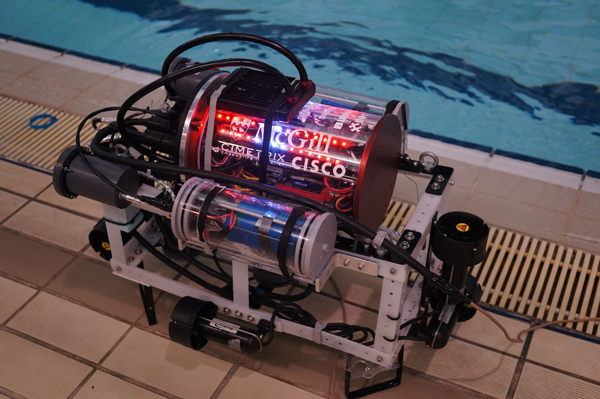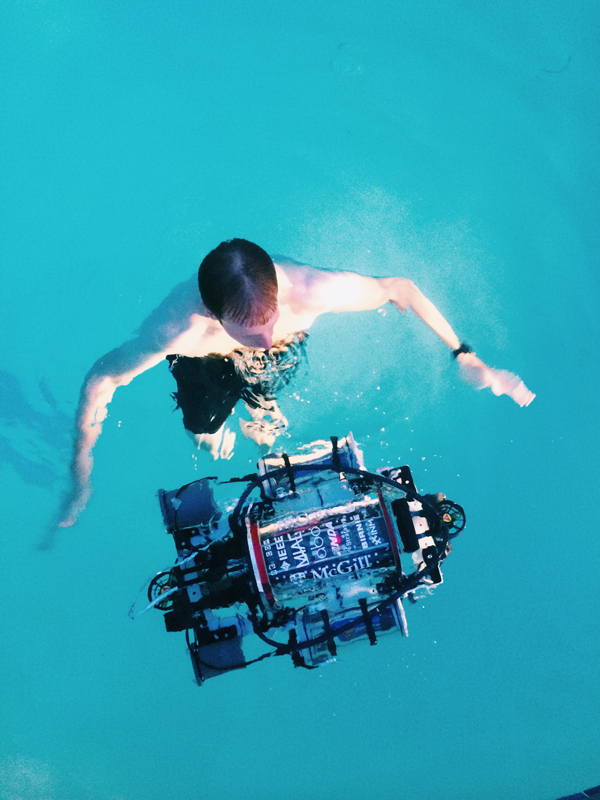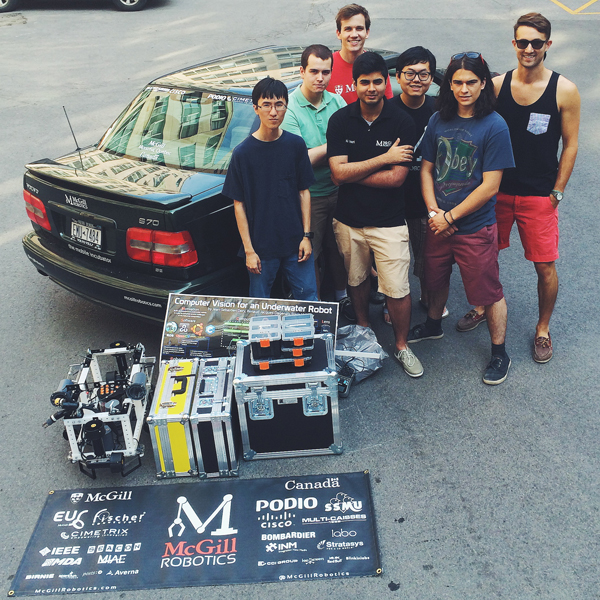
Team qualifies for Friday’s semifinals
By Neale McDevitt
A team of 25 McGill students is currently in San Diego taking part in a competition where ‘sinking to new lows’ is actually a good thing. After a solid run in Tuesday’s preliminary round, McGill Robotics has made it to the semifinals of the 17th International RoboSub Competition, thanks to the stellar performance of the team’s Autonomous Underwater Vehicle (AUV), Asimov.

The prestigious event is geared to advance the development of AUVs by challenging young engineers to perform realistic missions in an underwater environment. This year, 45 teams from around the world have taken on the challenge to design and build a small underwater vessel that can autonomously navigate a specified course while manoeuvring obstacles and completing tasks. The tasks include going through gates, shooting a torpedo through targets and locating a small item in the pool by tracking its acoustic ‘ping.’

“This competition has existed for 17 years and a lot of teams have competed year after year so they’ve been getting better and better,” said Nick Speal, project manager for McGill Robotics. “This is our first year so we’re not attempting all of the tasks [on the course]. It’s great to have made the semifinals because our goal has always been to build a strong robotics platform that we can build upon for next year. It’s all about learning along the way so that we can improve the system.”
The McGill AUV, called Asimov in honour of Sci Fi writer Isaac Asimov, who devised the Three Laws of Robotics, weighs 48 pounds and cruises at a top speed of 1.5 knots. The vehicle features six thrusters, holds several external manipulators, and boasts an array of sensors, artificial intelligence, and advanced computer vision systems. The integrated electrical, mechanical, computer and control systems are housed within a cylindrical pressure vessel. An unmanned vehicle, Asimov operates entirely independently.
Further proof that necessity really is the mother of all invention, Asimov was created only after another McGill Robotics’ vehicle, a lunar excavator named El Gordo, was retired after NASA closed its Lunabotics Mining Competition to participants outside the U.S. last year. “We had finished 12th out of 50 teams that year, so we were disappointed when we couldn’t compete any more, but with [the underwater competition] we can now say, McGill Robotics has explored all frontiers,” said Speal.

Building a sub from scratch is no easy task and the Robotics team knew it would need the input of a diverse group of people if it were to be successful. “Throughout the process we emphasized team before machine,” said Speal. “We’ve never done this before and we knew if we built a strong team, a solid machine would follow.”
Some 100 students were recruited, divided into the sub-groups of electrical, mechanical and software engineering. The fall was dedicated to the design phase and to researching different technologies that could meet the functional requirements. Asimov was built over the winter and testing at McGill’s pool began in earnest at the end of March.
Speal said that, once in the water, the team thought the summer would be spent fine-tuning things for the competition. “Of course there’s a lot of debugging that came up as everything came together,” he said. “One of the things we learned was how to solve problems that you didn’t design for. There are the known unknowns and then there are the unknown unknowns. There were challenges, but we handled them all.”
One of those challenges was transporting Asimov across the continent to San Diego. The team had heard a number of horror stories in which vehicles that were shipped long distances arrived broken and battered or didn’t show up at all. “The thought of losing all our hard work was too much,” said Speal.

Instead, Speal and Mike King (McGill Robotics’ Mechanical Division Manager), loaded Asimov into the back of Speal’s parents’ 2000 Volvo and hit the road on a week-long, cross-continent odyssey battling extreme heat with broken AC (Asimov’s heat-sensitive batteries were packed in a cooler for safe keeping). Along the way, Asimov may have become the first-ever submarine to visit the Grand Canyon.
Arriving safe and sound with their precious cargo, Speal and King joined the other 23 members of the team in San Diego and are now gearing up for Friday’s semifinals. But regardless of what happens from here on in, it is safe to say things have gone swimmingly.
For up-to-the-minute progress reports, check out the team’s website and click on the #ROBOSUB button.
